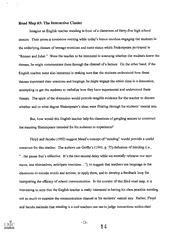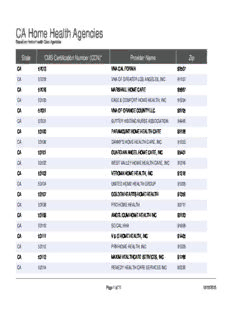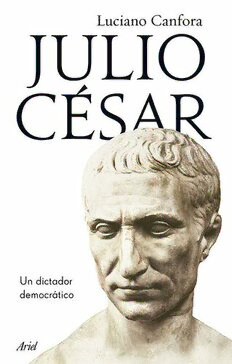
Preview Gracey's meat hygiene
Gracey’s Meat Hygiene This book is dedicated to the memory of two great veterinarians Dr Joseph Forde Gracey (1918–2001) and Dr James Andrew Storrar (1947–2006) Gracey’s Meat Hygiene Eleventh Edition Edited by David S. Collins MVB, DVPH(MH), MRCVS Robert J. Huey TD, MVB, DVPH(MH), MRCVS This edition first published 2015 © 2015 by John Wiley & Sons, Ltd Registered Office John Wiley & Sons, Ltd, The Atrium, Southern Gate, Chichester, West Sussex, PO19 8SQ, UK Editorial Offices 9600 Garsington Road, Oxford, OX4 2DQ, UK The Atrium, Southern Gate, Chichester, West Sussex, PO19 8SQ, UK 1606 Golden Aspen Drive, Suites 103 and 104, Ames, Iowa 50010, USA For details of our global editorial offices, for customer services and for information about how to apply for permission to reuse the copyright material in this book please see our website at www.wiley.com/wiley-blackwell The right of the author to be identified as the author of this work has been asserted in accordance with the UK Copyright, Designs and Patents Act 1988. All rights reserved. No part of this publication may be reproduced, stored in a retrieval system, or transmitted, in any form or by any means, electronic, mechanical, photocopying, recording or otherwise, except as permitted by the UK Copyright, Designs and Patents Act 1988, without the prior permission of the publisher. Designations used by companies to distinguish their products are often claimed as trademarks. All brand names and product names used in this book are trade names, service marks, trademarks or registered trademarks of their respective owners. The publisher is not associated with any product or vendor mentioned in this book. It is sold on the understanding that the publisher is not engaged in rendering professional services. If professional advice or other expert assistance is required, the services of a competent professional should be sought. The contents of this work are intended to further general scientific research, understanding, and discussion only and are not intended and should not be relied upon as recommending or promoting a specific method, diagnosis, or treatment by health science practitioners for any particular patient. The publisher and the author make no representations or warranties with respect to the accuracy or completeness of the contents of this work and specifically disclaim all warranties, including without limitation any implied warranties of fitness for a particular purpose. In view of ongoing research, equipment modifications, changes in governmental regulations, and the constant flow of information relating to the use of medicines, equipment, and devices, the reader is urged to review and evaluate the information provided in the package insert or instructions for each medicine, equipment, or device for, among other things, any changes in the instructions or indication of usage and for added warnings and precautions. Readers should consult with a specialist where appropriate. The fact that an organization or Website is referred to in this work as a citation and/or a potential source of further information does not mean that the author or the publisher endorses the information the organization or Website may provide or recommendations it may make. Further, readers should be aware that Internet Websites listed in this work may have changed or disappeared between when this work was written and when it is read. No warranty may be created or extended by any promotional statements for this work. Neither the publisher nor the author shall be liable for any damages arising herefrom. Library of Congress Cataloging-in-Publication Data Gracey’s meat hygiene / edited by D.S. Collins, R.J. Huey. – Eleventh edition. p. ; cm. Meat hygiene Preceded by Meat hygiene / J.F. Gracey, D.S. Collins, R.J. Huey. 10th ed. c1999. Includes bibliographical references and index. ISBN 978-1-118-65002-8 (cloth) I. Collins, D.S. (David S.), editor. II. Huey, R.J. (Robert J.), editor. III. Gracey, J.F. Meat hygiene. Preceded by (work): IV. Title: Meat hygiene. [DNLM: 1. Meat. 2. Food Inspection. 3. Food Safety. 4. Meat-Packing Industry. 5. Quality Control. WA 707] RA602.M4 363.19′29–dc23 2014016565 A catalogue record for this book is available from the British Library. Wiley also publishes its books in a variety of electronic formats. Some content that appears in print may not be available in electronic books. Cover images: Poultry top left: iStock © EEI_Tony; Poultry top right: iStock © ly-ly; Sheep centre right: Reproduced with permission of Ronald Siddle; Bull calves bottom: Reproduced with permission of David S. Collins; All other images: Reproduced with permission of Graham Fallows Cover design by hisandhersdesign Set in 10.5/12.5pt Minion by SPi Publisher Services, Pondicherry, India 1 2015 Contents Contributors xi Lungs 26 Pluck 26 Preface xiii Circulatory system (heart, arteries, capillaries and veins) 26 Acknowledgements xv Heart 26 Portal circulation 27 1 The food animals 1 Spleen (melt) 27 Dietary factors 2 Lymphatic system 28 World livestock production 3 Haemal lymph nodes 28 UK meat plants and throughputs 4 Lymph nodes of the ox 29 Cattle 4 Nodes of the head and neck 30 Breeds 4 Nodes of the chest and forequarter 30 Systems of beef production 6 Nodes of the abdomen and hindquarter 31 Growth promoters 7 Lymph nodes of the pig 33 Definitions 7 Head and neck 33 Sheep 7 Other nodes 33 Definitions 9 Urogenital system 34 Pigs 10 Urinary organs 34 Pig breeds 10 Genital organs 34 Pig breeds in the United Kingdom 11 Kidney 34 Pig production 11 Reproductive system 34 Pig meat production 13 Uterus 34 Glossary of terms 13 Udder 36 Additional facts 13 Endocrine system 36 Goats 13 Thymus 36 Poultry 14 Adrenal (suprarenal) bodies 36 Definitions 14 Testicles (testes) 37 Rabbits 15 Collection and yield of glands 37 Deer 16 Skin 37 Handling of deer 17 Horns 37 References 17 Muscular system 37 Further reading 17 Connective tissue 38 Form animal welfare council 17 Fat 38 2 Anatomy 19 Determination of age by dentition 38 Descriptive terms 19 Teeth 38 Osteology and arthrology 19 Determination of sex 39 Bones 19 Cattle 39 Digestive system 21 Sheep 40 Tongue 21 Pigs 41 Stomach 22 Horse and ox differentiation 41 Mucous membranes 22 Debasement of food Intestines 23 (adulteration and substitution) 41 Liver 24 Food tampering 43 Pancreas (gut sweetbread) 25 References 43 Respiratory system 26 Further reading 43 v vi Contents 3 Meat establishment construction Production of bacon and ham 69 and equipment 45 Cutting 70 Site 45 Application of the pickle 70 Environmental statement 45 Production of cooked hams 71 Submission of plans 46 Traditional dry-cured bacon 71 Area size 46 Alternative dry cure 71 Facilities 47 Smoking 71 Equipment design 50 Common defects in cured meat 71 Pest control 51 Micro-organisms on cured product 72 Small abattoir units 51 Refrigeration 72 Lairage 52 Mechanical refrigeration 72 Cattle lairage 52 Chilling of meat 73 Sheep lairage 52 Freezing of meat 75 Pig lairage 52 Freeze-drying or lyophilisation 76 Deer lairage 53 Storage of fresh meat 76 Clipping or cleaning of livestock 53 Vacuum packing 76 Manure disposal 53 Modified atmosphere packing 76 Slaughterhall 53 Refrigerated meat transport and storage 76 Stunning area 53 Changes in frozen meat 77 Bleeding area 54 ‘Weeping’ or ‘drip’ 77 Cattle carcase dressing 54 Durability of frozen meat 78 On-the-rail dressing 55 Effect of freezing on pathogenic Sheep slaughterhall 56 micro-organisms and parasites 78 Pig slaughterhall 57 Heat: Thermal processing 78 Singeing and scraping 58 Traditional canning methodology 79 Refrigeration accommodation 58 Treatment of food to be canned 79 Detained meat room 59 Canning operations 80 Condemned meat room 60 Canning of meats 82 Hide and skin store 60 Foods packed in glass 82 Gut and tripe room 60 Spoilage in canned foods 82 Red offal room 60 Types of spoilage 83 The edible fat room 61 The public health aspect of canned Cutting rooms 61 foods 85 Equipment wash 61 Other methods of meat preservation 86 Fresh meat dispatch area 61 Antioxidants 86 Vehicle washing 62 Preservatives 86 General amenities for personnel 62 Irradiation 86 Veterinary office 62 Infrared radiation 86 Treatment of effluent 62 Ultraviolet radiation 86 Pollution parameters 63 Ionising radiation 86 Treatment 63 High pressure 87 Preliminary treatment: Screening, References 87 solids and grit removal 63 Further reading 88 Secondary treatment 64 Further reading 65 5 Plant sanitation 89 Reasons for cleaning and disinfecting 4 Preservation of meat 67 plant 89 Physical changes in stored meat 67 ‘Scotoma effect’ or ‘factory-blindness’ 90 Chemical changes in stored meat 68 The chemistry of cleaning 90 Water activity or water availability (a ) 68 The soil 91 w Meat curing 68 The substrate: Materials of construction 91 Salt 68 Energies of cleaning 92 Ingredients used in curing 69 Chemical and physical reactions of cleaning 92 Contents vii Detergents: Design and choice 95 Animal husbandry in the lairage 127 Principles of disinfection 95 Moving animals within the lairage 127 Biocidal active components 95 Social stress 128 Disinfectants: Design and choice 97 Watering 128 Hygiene equipment and application methods 97 Fasting 128 Manual cleaning 98 Resting of animals prior to slaughter 129 Foam cleaning 98 Pre-slaughter handling and meat quality 129 Foam and disinfectant application equipment 98 Stress and the animal 129 Gels 99 Stress and meat quality 130 Spray 100 Pre-slaughter feeding of sugars 131 Fogging 100 Traumatic injury 131 Knife and cutting tool disinfection Time of bruising 131 during processing 100 Rough handling 132 Machine washing 102 Presence of horns 132 Cleaning-in-place (CIP) 102 Temperament 132 Rinse systems 104 Stunning box design 132 Contamination and re-contamination 105 Mixing of animals 133 Air 105 Breed 133 Water 106 Incentives and education 133 People 106 References 133 Surfaces 106 Further reading 134 Cleaning procedures 106 The cleaning sequence 106 7 Humane slaughter 135 Monitoring of hygiene 108 Pre-slaughter handling/restraint 136 Training 110 Cattle movement and restraint 136 Safety 110 Pig movement and restraint 137 Effluent and external odour control 110 The slaughtering process 137 Conclusion 111 Assessment of unconsciousness at Note 111 slaughter 137 References 112 Methods of stunning 138 Percussive stunning 138 6 From farm to slaughter 113 Head sites for percussive stunning 140 Production of clean, healthy livestock 113 Water jet stunning 142 Clean livestock 115 Carbon dioxide and other gas mixtures 142 Healthy livestock 117 Electrical stunning 144 Safe use of animal medicines 117 Effect of stunning on meat quality 146 Safe disposal of animal waste 117 Slaughter of minor species 146 Animal welfare on the farm 119 Slaughter of deer 146 Assessment of an animal’s welfare 119 Slaughter of ostriches 147 Transportation of livestock 122 Slaughter of rabbits 147 Loading and unloading 122 Other methods of slaughter 147 The journey to slaughter 123 Slaughter of poultry 148 EU transport legislation 123 Electrical stunning of poultry 148 Protection during transport 123 Assessment of unconsciousness in Means of transport 123 electrical water bath stunned poultry 149 Space allowances 123 Stunning/killing poultry with controlled Duties of transporters 123 atmospheres 149 Feed, water and rest periods 123 Percussive stunning of poultry 150 Treatment of sick animals 124 Other methods of slaughter 150 Travel documentation 124 Effects of stunning on poultry meat quality 150 Loss of weight during transport 124 Pithing 150 Transport mortality 125 Bleeding 151 Lairage construction 126 Cattle 151 viii Contents Sheep 151 Rendering processes 183 Pigs 152 References 184 Efficiency of bleeding 153 Slaughter without pre-stunning 153 9 Meat inspection protocols 185 Shechita – Jewish religious slaughter 153 The case for change 185 Muslim methods of slaughter 156 The holistic approach 187 Slaughter of poultry without stunning 157 Integrated Food Safety Assurance 187 References 157 Farm to fork 187 Further reading 158 Food chain information 187 Ante-mortem inspection 188 8 Meat hygiene practice 159 Ante-mortem inspection procedure in the Meat and animal by-products 159 slaughter establishment 189 Hygienic production 159 Practical ante-mortem procedure 190 Sources of contamination 159 Emergency slaughter animals 191 Outer integument – hide, hair, fleece or skin 159 Emergency slaughter: The decision on farm 191 Gastrointestinal tract 160 Emergency slaughter: The decision Stunning and sticking 160 at the slaughter establishment 192 Physical contact with structures 160 Post-mortem inspection 192 Operatives 160 Facilities for post-mortem inspection 192 Equipment and utensils 161 Carcase identification and traceability 193 The slaughter hall environment 161 Traditional post-mortem inspection 194 Vermin and pests 161 Traditional post-mortem inspection Chemical contamination 162 of cattle 194 Methods of reducing contamination 162 Traditional post-mortem inspection Dealing with the dirty animal 162 of calves 196 Clipping cattle on line 163 Traditional post-mortem inspection Protecting the meat from the worker 163 of sheep and goats 196 Good hygiene practice 165 Traditional post-mortem inspection of pigs 196 Layout and flow lines 167 Traditional post-mortem inspection Dressing techniques – Removal of of equines 197 hide/fleece/hair 167 Traditional post-mortem inspection Preventing contamination from the of poultry 197 gastrointestinal tract 170 Decisions at post-mortem examination 198 Post-slaughter decontamination 172 Common post-mortem findings 203 Water 172 Abscesses 203 Trimming 173 Omphalophlebitis 204 Chemical treatments 173 Arthritis 204 Bacteriophages 174 Oedema 204 Ultraviolet and pulsed high-intensity Pneumonia and pleurisy 205 light 174 Endocarditis 206 Outputs of the slaughterhouse 174 Pericarditis 207 Treatment of edible co-products 175 Pyelonephritis 207 Fats 175 Bruising 208 Edible fat rendering 176 Pigmentation 208 Stomach and intestines 176 Haematogenous pigments 209 Bones 177 Bile pigments 209 Hides and skins 177 Porphyrin 210 Animal by-products 178 Lipofuscin (‘wear-and-tear pigment’, Category 1 178 pigment of brown atrophy, Category 2 179 lipochrome, haemofuscin) 211 Category 3 (can be used for pet food) 180 Xanthosis (xanthomatosis, Materials for technical uses 181 osteohaematochromatosis, Hygiene requirements for animal brown atrophy) 211 by-product processing establishments 183 Tumours 211
The list of books you might like

The Subtle Art of Not Giving a F*ck

Can’t Hurt Me: Master Your Mind and Defy the Odds

A Thousand Boy Kisses

The Strength In Our Scars

DTIC ADA561944: A Smart Microwave Vacuum Electron Device (MVED) Using Field Emitters

BY ORDER OF THE SECRETARY OF THE AIR FORCE AIR FORCE INSTRUCTION 11-2E-3 ...

BVCM002573 M-30

Shandygaff by Christopher Morley

ERIC ED427347: Road Maps To Understand School Communication.

DTIC ADA454761: Automated Discovery of Mimicry Attacks

The Life of Daniel De Foe by George Chalmers

sürdürülebilirlik raporu 2015

CA Home Health Agencies

ERIC ED362662: Training an Aging Work Force.

Corbows Theory by Lee Wallot

C.A. No. 12088-12089/2018

Union Government, Extraordinary, 1993-01-29, CSL, Ref. CSL

British by AUTHOR

Korpuskatalog till doktorsavhandling "Vikingatida runbleck: Läsningar och tolkningar" / Korpuskatalog till "Viking-Age Runic Plates: Readings and Interpretations"

Bullets Billets by Bruce Bairnsfather

The Luck of the Dudley Grahams by Alice Calhoun Haines

Journal of Comparative Physiology 1993: Vol 173 Table of Contents

Julio César. Un dictador democratico

